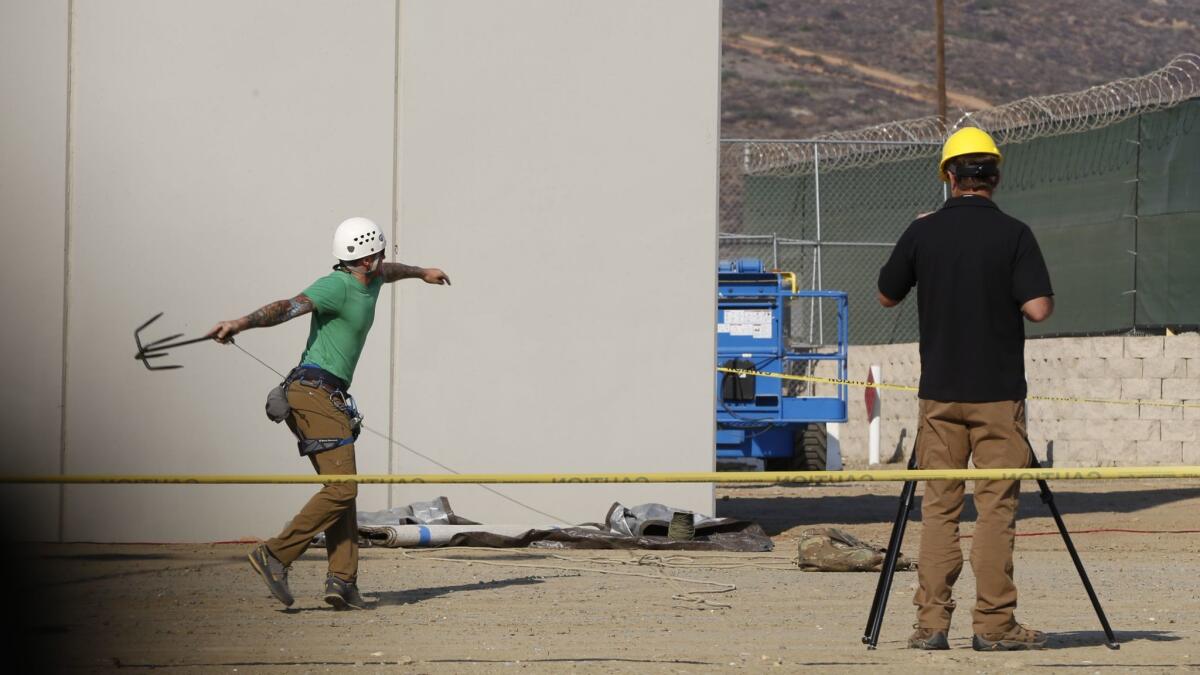Grappling hooks and harnesses: Agents put border wall prototypes to the test

Officials have begun testing how easily someone can climb over the border wall prototypes near the Otay Mesa port of entry, progressing to the next phase of a process that may make President Trump’s vision a reality.
Testing will include whether and how quickly someone could go over the top of, under and through the walls.
Both anti-climb and anti-dig testing will happen at the prototype site in Otay Mesa, according to Customs and Border Protection officials. Anti-breach testing will happen with smaller versions of the walls at an undisclosed, secure site in San Diego.
“This phase is not structured as pass/fail, but rather the results will provide CBP leadership the best attributes among the constructed designs for inclusion in future border wall design specifications,” an agency official said.
The six companies selected to build the eight prototypes completed construction in October. The walls then were given one month to cure before testing began Nov. 28.
Media have not been allowed at the prototype site during testing, but much of the activity is visible from Mexico through peepholes in the current border fence.
Early in the day on Wednesday, a group of about 10 testers wearing helmets moved from wall to wall performing different checks. Several of the men wore climbing harnesses.
One man nimbly straddled several of the walls, swinging a backpack from one side to the other.
On the walls with rounded tops, two men in a lift tried to affix a three-sided hook over the top. After the hook repeatedly came loose, they managed to get it to hold on the westernmost wall — a tan, non-concrete structure with a small round tube on top, built by W.G. Yates & Sons Construction Co. of Philadelphia, Miss.
A man in a green shirt standing at the bottom of the wall then tested whether the hook would hold the weight of a person. He climbed part of the way up, hanging briefly with his feet against the wall before coming back down.
Many of the testers involved are part of Border Patrol’s tactical unit, the agency’s version of a SWAT team.
Around lunchtime, several of the men took turns trying to throw a grappling hook at just the right angle so that it would fly high enough to catch on the metal lattice of the only prototype with spikes on top.
On the first attempt, a man in a green shirt lobbed the four-pronged hook skyward. It fell without touching the wall, not nearly reaching the height of the spikes mounted on the 30-foot concrete wall designed by Houston-based Texas Sterling Construction Co.
After several tries, the hook hit the metal mesh that angles toward the southern side of the wall, pointing the spikes at potential climbers. It didn’t catch.
The man paused, resting his hands on his knees, before walking to pick up the hook and try again.
Soon after, he handed the grappling hook to one of his colleagues and sat down to rest.
The second man had his throwing hand wrapped. On his first toss, he also missed the wall completely.
Before handing the hook over to a third tester, he tried tossing it backward over his head in what basketball players call a “granny shot.”
It still didn’t stick.
The third man wore a glove to protect his hand from the hook. He finally arced the hook up to the wire mesh, and it caught.
After a tug on the rope, the hook came down easily. Everyone ducked out of the way as it fell.
The first man borrowed the third man’s gloves to try again.
As the smell of smoke from a fire over the mountain in Mexico began to waft through the air, he launched the hook all the way over the spikes and wire mesh to land on the concrete ledge on the north side of the wall.
The group cheered.
Two men in a lift maneuvered to the top of the wall to affix the hook firmly to the metal mesh.
When the men tested the rope’s ability to take weight, it snapped across the spikes with one sharp tug.
Officials expect to finish testing by mid-December, according to CBP.
Morrissey writes for the San Diego Union-Tribune.
kate.morrissey@sduniontribune.com
Morrissey writes for the San Diego Union-Tribune
More to Read
Start your day right
Sign up for Essential California for news, features and recommendations from the L.A. Times and beyond in your inbox six days a week.
You may occasionally receive promotional content from the Los Angeles Times.







